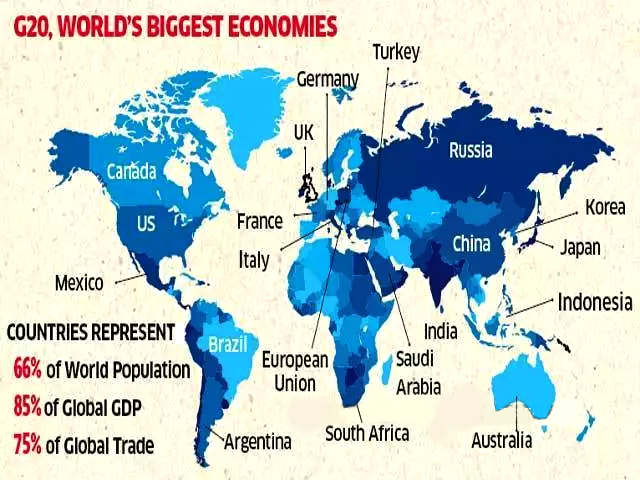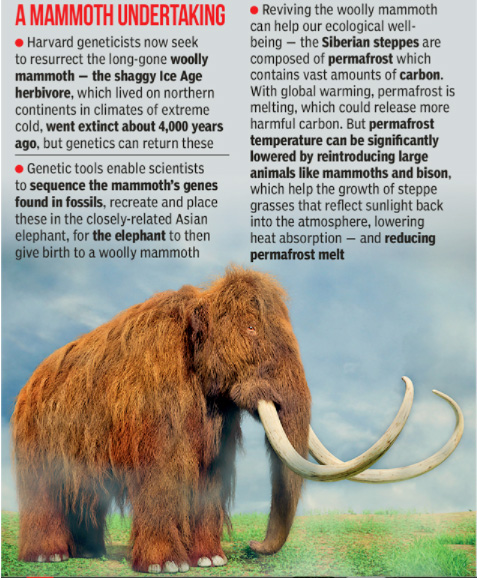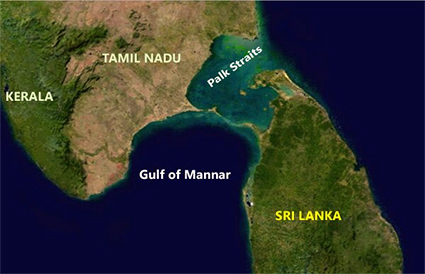Indian Economy
G-20 Agriculture Meet 2021
Why in News
Recently, India’s Agriculture Minister addressed the G20 Agriculture meeting virtually.
- It is one of the ministerial meetings organised as part of the G20 Leaders Summit 2021 to be hosted by Italy in October 2021.
G20
- About:
- It is an informal group of 19 countries and the European Union (EU), with representatives of the International Monetary Fund and the World Bank.
- It does not have a permanent secretariat or Headquarters.
- The membership comprises a mix of the world’s largest advanced and emerging economies, representing about two-thirds of the world’s population, 85% of global gross domestic product, 80% of global investment and over 75% of global trade.
- It is an informal group of 19 countries and the European Union (EU), with representatives of the International Monetary Fund and the World Bank.
- Members:
- Argentina, Australia, Brazil, Canada, China, France, Germany, India, Indonesia, Italy, Japan, Republic of Korea, Mexico, Russia, Saudi Arabia, South Africa, Turkey, the United Kingdom, the United States and the EU.
Key Points
- Highlights of the Meet:
- Signed a final statement named the “Florence Sustainability Charter”.
- It will strengthen cooperation between G20 members and developing countries on food and agriculture to share knowledge and help developing the internal production capacities best suited to local needs, thus contributing to the resilience and recovery of agriculture and rural communities.
- Reaffirmed their intention to reach the goal of zero hunger, which is also threatened by the consequences of Covid-19.
- Reaffirmed the commitment to achieve food security in the framework of the three dimensions of sustainability: economic, social and environmental.
- Signed a final statement named the “Florence Sustainability Charter”.
- India’s Stand:
- Focus on Traditional Food:
- Emphasised on re-introducing traditional food items including millet, other nutritious cereals, fruits and vegetables, fish, dairy and organic products in the diet of the people.
- Their production has been phenomenal in India in recent years and India is becoming a destination country for healthy food items.
- The United Nations (UN) has accepted India’s proposal and declared 2023 as the International Year of Millets and urged the G20 nations to support the celebration of the millet year to promote nutrition and sustainable agriculture.
- Emphasised on re-introducing traditional food items including millet, other nutritious cereals, fruits and vegetables, fish, dairy and organic products in the diet of the people.
- Biofortified Food:
- Biofortified varieties, which are the source of a staple diet rich in micronutrients, are being promoted to remove malnutrition.
- About 17 such varieties of different crops have been developed and released for cultivation.
- Biofortified varieties, which are the source of a staple diet rich in micronutrients, are being promoted to remove malnutrition.
- Water Resource:
- India has also taken steps to increase the optimal use of water resources, create infrastructure for irrigation, conserve soil fertility with balanced use of fertilizers, and provide connectivity from farms to markets.
- Indian Agri-Sector in Covid:
- Indian agriculture has achieved great success after the country's independence, and the sector also remained unaffected even during the Covid pandemic.
- India Resolved to:
- Continue working together to achieve the Poverty Reduction' and 'Zero Hunger Goal as part of the sustainable development goals.
- Cooperate in research and development as well as exchange of best practices to enhance productivity.
- Focus on Traditional Food:
- Related Indian Initiatives:
- The 'Per Drop-More Crop' scheme for irrigation and 'Paramparagat Krishi Vikas Yojana' for organic farming is being successfully implemented.
- Pradhan Mantri Fasal Bima Yojana is being implemented to provide insurance cover for the farmers.
- To address the malnutrition problem, India is running the world's largest food-based safety net programme, which includes the Public Distribution System and the Mid-Day Meal Scheme.
- The government is also providing an annual income support of Rs 6,000 under the Pradhan Mantri Kisan Samman Nidhi (PM-KISAN).
Governance
Front-of-Pack Labelling
Why in News
The Food Safety and Standards Authority of India (FSSAI), in 2018, released the Draft Food Safety And Standards (Labelling And Display) Regulation.
- However, even after so many expert panel recommendations and regulations, India still does not have a clear labelling or Front-of-pack (FoP) Labelling System, which can warn consumers about harmful levels of fat, salt and sugar in processed foods.
Key Points
- About Front-of-Pack (FoP) Labelling System:
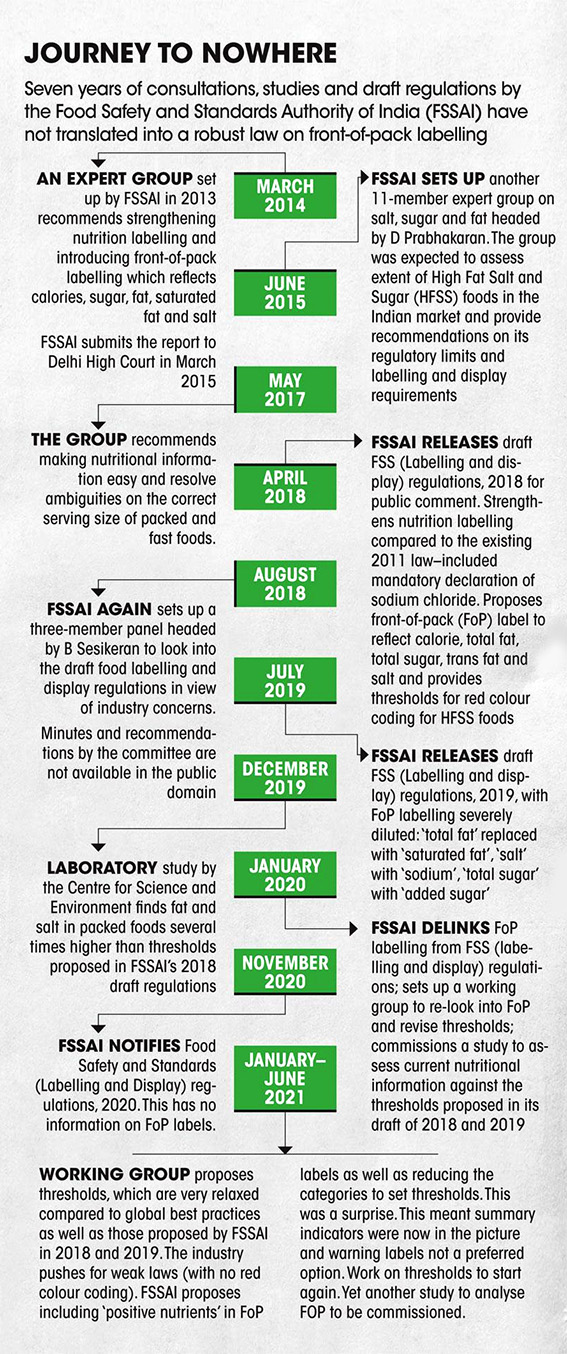
- FoP labelling system has long been listed as one of the global best practices to nudge consumers into healthy food choices.
- It works just the way cigarette packets are labelled with images to discourage consumption.
- As India is experiencing a dietary shift, with people increasingly consuming more processed and ultra-processed foods and a burgeoning market, these factors prompt the need for FoP labelling for India.
- It will play a handy role in fighting increasing obesity and many non-communicable diseases.
- The World Health Organization (WHO) defines FoP labels as nutrition labelling systems that are presented on the front of food packages in the principal field of vision; and present simple, often graphic information on the nutrient content or nutritional quality of products.
- To complement the more detailed nutrient declarations provided on the back of food packages.
- The Codex Alimentarius Commission, an international food standards body established jointly by WHO and the Food and Agriculture organization (FAO), mentions that “FoP labelling is designed to assist in interpreting nutrient declarations”.
- FoP labelling system has long been listed as one of the global best practices to nudge consumers into healthy food choices.
- About the Draft Food Safety And Standards (Labelling And Display) Regulations:
- The rules mandates colour-coded labels on food items.
- The draft regulation has been brought to encourage consumers to make healthier food choices and inform them about what the product actually contains.
- The front of all packaged food items will have to display the total number of calories, saturated and trans fats, salt, and added sugar content as well as the proportion of the daily energy needs fulfilled by the food item.
- FSSAI has also changed the symbol of vegetarian food from a green circle to a green triangle to help color blind people distinguish it from the brown circle denoting non-vegetarian food.
- According to the proposed regulation, if the total amounts of calories, fats, trans-fats, sugar, and sodium per serving exceed the stipulated limits, it would be indicated in red colour.
- Issues Pertaining to these Rules:
- Masking of Positive Nutrients: Most consumer organisations objected as ‘positive nutrients’ will mask the negative impact of high fat, salt and sugar in the food and the industry will use it to mislead the consumer.
- FSSAI proposed to also consider ‘positive nutrients’ in the FoP label. It was about giving scores to ‘positive nutrients’ such as proteins, nuts, fruits and vegetables in the name of promoting wholesome foods.
- Restricted Target Audience: The labelling format appears to be aimed only at individuals who are literate and nutritionally aware.
- Further, limited general and nutrition literacy mean understanding of the text-intensive nutrient information is difficult.
- Objections from Food Industry: Indian food industries have expressed many concerns over the proposed format, especially using the colour red as it indicates danger and could dissuade consumers from their products.
- Masking of Positive Nutrients: Most consumer organisations objected as ‘positive nutrients’ will mask the negative impact of high fat, salt and sugar in the food and the industry will use it to mislead the consumer.
Way Forward
- More Focus on Pictorial Representation: Almost a quarter of the Indian population is illiterate,therefore pictorial representation would allow better engagement and understanding.
- It might be beneficial for front-of-pack labelling in India to be symbol based, with food images, logos, and health benefits.
- Need for More R&D: Mandatory front of pack labelling must be preceded by strong research and in a format that is understandable and acceptable to all.
Indian Economy
Digital Payment Systems
Why in News
The central banks of India and Singapore will link their respective fast digital payment systems - Unified Payments Interface (UPI) and PayNow - for “instant, low-cost, cross-border fund transfers”.
- The linkage is targeted to be operationalised by July 2022.
Key Points
- About:
- The Unified Payments Interface (UPI)-PayNow linkage is a significant milestone in the development of infrastructure for cross-border payments between India and Singapore, and closely aligns with the G20’s financial inclusion priorities of driving faster, cheaper and more transparent cross-border payments.
- India is a member of G20.
- The linkage builds upon the earlier efforts of NPCI International Private Ltd (NIPL) and Network for Electronic Transfers (NETS, Singapore) to foster cross-border interoperability of payments using cards and QR codes between India and Singapore and will anchor trade, travel and remittance flows between the two countries.
- NIPL is the subsidiary of NPCI to popularise domestic payments technologies such as UPI and RuPay abroad and co-create payment technologies with other countries.
- The initiative is in line with its vision of reviewing corridors and charges for inbound cross-border remittances outlined in the Payment Systems Vision Document 2019-21.
- From an investing perspective, this will incentivize more retail investors to access global markets. Currently, they pay up to Rs.3,000 in inter-bank charges which are over and above the Liberalised Remittance Scheme (LRS) processing fees by banks.
- LRS of the Reserve Bank of India (RBI) allows resident individuals to remit a certain amount of money during a financial year to another country for investment and expenditure.
- The Unified Payments Interface (UPI)-PayNow linkage is a significant milestone in the development of infrastructure for cross-border payments between India and Singapore, and closely aligns with the G20’s financial inclusion priorities of driving faster, cheaper and more transparent cross-border payments.
- UPI and Other Indian Payment Systems:
- Unified Payments Interface:
- It is an advanced version of Immediate Payment Service (IMPS)- round–the-clock funds transfer service to make cashless payments faster, easier and smoother.
- UPI is a system that powers multiple bank accounts into a single mobile application (of any participating bank), merging several banking features, seamless fund routing & merchant payments into one hood.
- National Payments Corporation of India (NPCI) launched UPI with 21 member banks in 2016.
- National Electronic Funds Transfer:
- NEFT is a nation-wide payment system facilitating one-to-one funds transfer. Under this Scheme, individuals, firms and corporates can electronically transfer funds from any bank branch to any individual, firm or corporate having an account with any other bank branch in the country participating in the Scheme.
- There is no limit – either minimum or maximum – on the amount of funds that could be transferred using NEFT.
- However, the maximum amount per transaction is limited to Rs. 50,000/- for cash-based remittances within India and also for remittances to Nepal under the Indo-Nepal Remittance Facility Scheme.
- RuPay Card Scheme:
- The name, derived from the words ‘Rupee and ‘Payment’, emphasises that it is India’s very own initiative for Debit and Credit Card payments.
- The card can also be used for transactions in Singapore, Bhutan, UAE, Bahrain and Saudi Arabia.
- Unified Payments Interface:
Governance
Rail Kaushal Vikas Yojana
Why in News
Recently, the Ministry of Railways launched Rail Kaushal Vikas Yojana (RKVY) under Pradhan Mantri Kaushal Vikas Yojana (PMKVY).
Key Points
- About:
- This is a skill development programme, where training will be provided to youth with a special focus on jobs that are relevant to the Railways.
- The training will be provided in four trades viz. Electrician, Welder, Machinist and Fitter and other trades will be added by zonal railways and Production units based on regional demands and needs assessment.
- Training will be provided to apprentices under the Apprentice Act 1961.
- Objectives:
- To impart training skills to the youth in various trades to bring qualitative improvement.
- To train 50,000 candidates over the next three years.
- Eligibility:
- Candidates who are 10th passed and between 18-35 years shall be eligible to apply. Participants in the scheme shall however have no claim to seek employment in Railways on the basis of this training.
- Significance:
- The scheme will not only improve the employability of the youth but also upgrade the skills of self-employed and those who are working with contractors through reskilling and up-skilling.
Pradhan Mantri Kaushal Vikas Yojana
- About:
- Launched in 2015, it is a flagship program of the Ministry of Skill Development and Entrepreneurship (MSDE).
- It aims to mobilize youth to take up skill training with the aim of increasing productivity and aligning the training and certification to the needs of the country.
- Owing to the success of PMKVY 1.0 wherein more than 19 lakh students were trained as against the target of 24 lakh, the scheme was relaunched as PMKVY 2.0 (2016-2020) with an allocated budget of Rs. 12000 Crores that aimed to train 10 million youth by the year 2020.
- And further PMKVY 3.0 was launched in 2021, in a bid to empower India’s youth with employable skills by making over 300 skill courses available to them. It envisages training of eight lakh candidates over a scheme period of 2020-2021 with an outlay of Rs. 948.90 crore.
- Key Components:
- Short Term Training: Training as per National Skills Qualification Framework (NSQF) is provided to those who are either school/college dropouts or unemployed.
- Recognition of Prior Learning (RPL): An individual with a certain set of skills or with prior learning experience is assessed and certified under RPL with grade according to the NSQF.
- Special Projects: This component ensures training in special areas and premises of government bodies and corporate. It aims to encourage training in vulnerable and marginalized groups of society.
- Training Partners (TPs) are mandated to organize Kaushal and Rozgar Melas every six months, thus providing placement assistance to certified ones.
Other Related Initiatives
- National Career Service Project.
- Skills Acquisition and Knowledge Awareness for Livelihood (SANKALP).
- Skills Strengthening for Industrial Value Enhancement (STRIVE).
- Kaushalacharya Awards.
- Scheme for Higher Education Youth in Apprenticeship and Skills (SHREYAS).
- Atma Nirbhar Skilled Employee Employer Mapping (ASEEM).
- Skill Certification.
- YuWaah Youth Skilling Initiative.
Biodiversity & Environment
Woolly Mammoths
Why in News
The United States’ startup Colossal Biosciences has announced its plan to bring woolly mammoths, or animals like them, back from extinction and into the frosty landscape of the Siberian tundra (treeless polar desert).
Key Points
- About:
- Mammoth, (genus Mammuthus), any member of an extinct group of elephants found as fossils in Pleistocene deposits over every continent except Australia and South America and in early Holocene deposits of North America.
- The Pleistocene Epoch began 2.6 million years ago and ended 11,700 years ago.
- The Holocene Epoch began 11,700 years ago and continues through the present.)
- Woolly Mammoths: The woolly, Northern, or Siberian mammoth (Mammuthus primigenius) is by far the best-known of all mammoths.
- The relative abundance and, at times, excellent preservation of this species’s carcasses found in the permanently frozen ground of Siberia has provided much information about mammoths’ structure and habits.
- Cause of Extinction:
- It is believed that mammoths disappeared because of a change in climate, disease, hunting by humans, or perhaps some combination of these.
- Mammoth, (genus Mammuthus), any member of an extinct group of elephants found as fossils in Pleistocene deposits over every continent except Australia and South America and in early Holocene deposits of North America.
- De-extinction of Woolly Mammoths:
- Need:
- Restoration of Ecosystem: When mammoths disappeared from the Arctic some 4,000 years ago, shrubs overtook what was previously grassland.
- Mammoth-like creatures could help restore this ecosystem by compressing shrubs, knocking over trees, and fertilising grasses with their faeces.
- Reduce Climate Change:
- If the current Siberian permafrost melts, it will release potent greenhouse gases.
- De-extinction will prevent the permafrost from melting. Compared to tundra, grassland might reflect more light and keep the ground cooler.
- Restoration of Ecosystem: When mammoths disappeared from the Arctic some 4,000 years ago, shrubs overtook what was previously grassland.
- Technology Used: The CRISPR gene editing technology will be used to modify Asian elephant embryos.
- Asian elephants are the mammoth’s closest living relative so their genomes resemble those of woolly mammoths.
- Need:
- Concerns Raised:
- Disturb the Ecosystem: Bringing back extinct species, whose ecological niches may no longer exist, will upset existing ecosystems.
- Opportunity Cost:
- The de-extinction could distract from more cost-effective efforts to protect biodiversity or mitigate climate change.
- The possible moral hazards that may arise if people start believing extinction is not forever.
- Even if de-extinction programs are successful, they will likely cost more than saving existing species from extinction.
- Once de-extinction becomes possible, the need to protect species from extinction will seem less urgent.
- No Guarantee of Behaviour Adoption: Even if newly engineered mammophants contain mammoth DNA, there is no guarantee these hybrids will adopt the behaviours of ancient mammoths.
- For instance, we inherit more than just DNA sequences from our parents. We inherit epigenetic changes, wherein the environment around us can affect how those genes are regulated.
- We also inherit our parents’ microbiome (colonies of gut bacteria), which plays an important role in our behaviours.
- The behaviours animals learn from observing other members of their species. The first mammophants will have no such counterparts to learn from.
Tundra
- The tundra climate region occurs between 60° and 75° of latitude, mostly along the Arctic coast of North America and Eurasia and on the coastal margins of Greenland.
- Tundra winters are long, dark, and cold, with mean temperatures below 0°C for 6 to 10 months of the year. There is a layer of permanently frozen ground below the surface, called permafrost.
- Structurally, the Tundra is a treeless expanse that supports communities of sedges and heaths as well as dwarf shrubs.
Indian Economy
District Level Committees for Power Related Schemes
Why in News
Recently, the Ministry of Power has issued an order for the setting up of District Level Committees to improve the quality of electricity supply in the country.
Key Points
- District Level Committees:
- About:
- All States and Union Territories will have to notify and ensure establishment of these District Electricity committees, under intimation to the Ministry of Power.
- It will oversee all power related schemes of the government and also its impact on the provision of services to the people. It will meet at District Headquarters at least once in three months.
- Composition:
- The committee would comprise the most senior member of Parliament (MP) in the district as the Chairperson, other MPs in the district as Co-chairpersons, District Collector as Member Secretary, among others.
- About:
- Power Sector in India:
- About:
- India’s power sector is one of the most diversified in the world. Sources of power generation range from conventional sources such as coal, lignite, natural gas, oil, hydro and nuclear power to viable non-conventional sources such as wind, solar, and agricultural and domestic waste.
- India is the third-largest producer and second-largest consumer of electricity in the world.
- 100% FDI (Foreign Direct Investment) is permitted under automatic route in the power sector.
- Electricity is a concurrent subject (Seventh Schedule of the Constitution).
- Nodal Agency:
- The Ministry of Power is primarily responsible for the development of electrical energy in the country.
- It administers the Electricity Act, 2003 and the Energy Conservation Act, 2001.
- The Ministry of Power is primarily responsible for the development of electrical energy in the country.
- Roadmap for Future:
- The Government has released its roadmap to achieve 175 GW capacity in renewable energy by 2022, which includes 100 GW of solar power and 60 GW of wind power.
- The Government is preparing a 'rent a roof' policy for supporting its target of generating 40 gigawatts (GW) of power through solar rooftop projects by 2022.
- The Ministry of New and Renewable Energy (MNRE) is the nodal Ministry for all matters relating to new and renewable energy.
- The Government has released its roadmap to achieve 175 GW capacity in renewable energy by 2022, which includes 100 GW of solar power and 60 GW of wind power.
- About:
- Related Government Initiatives:
- Pradhan Mantri Sahaj Bijli Har Ghar Yojana (Saubhagya): To ensure electrification of all willing households in the country in rural as well as urban areas.
- Deendayal Upadhyaya Gram Jyoti Yojana (DDUGJY): Provides for separation of agriculture and non-agriculture feeders, strengthening and augmentation of sub-transmission and distribution infrastructure in rural areas including metering at distribution transformers, feeders and consumers end.
- GARV (Grameen Vidyutikaran) App: To monitor transparency in implementation of the electrification schemes, Grameen Vidyut Abhiyanta (GVAs) have been appointed by the government to report progress through the GARV app.
- Ujwal Discom Assurance Yojana (UDAY): For operational and financial turnaround of Discoms.
- 4 Es in the Revised Tariff Policy: The 4Es include Electricity for all, Efficiency to ensure affordable tariffs, Environment for a sustainable future, Ease of doing business to attract investments and ensure financial viability.
Important Facts For Prelims
Sea Cucumber
Why in News
Recently, the Indian Coast Guard (ICG) has seized two tonnes of sea cucumber, a banned marine species, in the Gulf of Mannar and Palk Bay areas in Tamil Nadu.
Key Points
- About:
- Sea cucumbers are marine invertebrates that live on the seafloor found generally in tropical regions. They're named for their unusual oblong shape that resembles a fat cucumber.
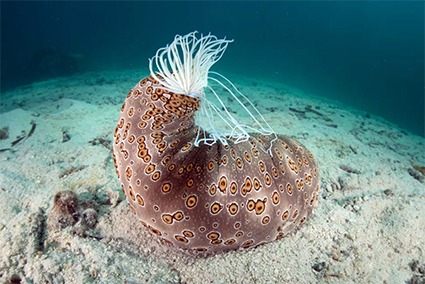
- There are about 1,250 species of sea cucumber, all of which belong to the taxonomic class Holothuroidea.
- This class falls under the Echinodermata phylum, which also includes many other well-known marine invertebrates, such as sea stars, sea urchins and sand dollars.
- They are crucial to maintain the balance of ocean habitats.
- Sea cucumbers are marine invertebrates that live on the seafloor found generally in tropical regions. They're named for their unusual oblong shape that resembles a fat cucumber.
- Significance:
- They are an integral part of the coral ecosystem as one of the main by-products of the sea cucumbers digestion of sand is calcium carbonate and this is essential for the survival of the coral reefs.
- They act like garbage collectors of the ocean world, and they recycle nutrients, thus playing an important role in keeping coral reefs in good condition.
- Threats:
- Illegal Trading and smuggling since the species is high in demand across south-east Asia, mainly China, for food and traditional medicine.
- Protection:
- IUCN Red List: Brown Sea Cucumber (Endangered), Blackspotted Sea Cucumber (Least Concern), Blue Sea Cucumber (Data Deficient), etc.
- Wildlife Protection Act, 1972: Schedule I.
- Conservation Efforts:
- In 2020, the Lakshadweep Islands administration created the world’s first conservation area - 239 sq. km - for sea cucumbers.
Important Facts For Prelims
Delhi-Mumbai Expressway: World's Longest
Why in News
Recently, the Union Minister for Road Transport and Highways concluded the two-day review of the work progress on the eight-lane Delhi-Mumbai Expressway.
- It will be the world’s longest highway once completed. It is expected to be completed by March 2023.
Key Points
- About:
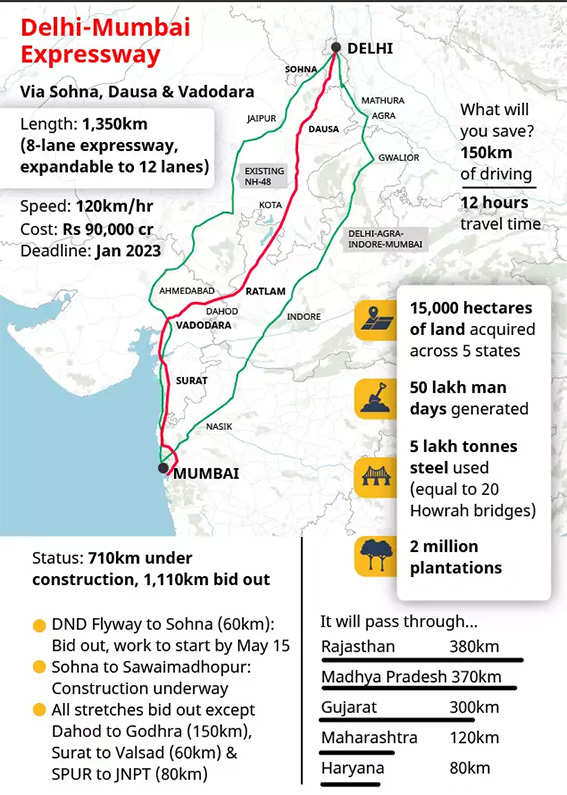
- It is a 1380-km eight-lane expressway that can be expanded to a 12-lane expressway depending on the volume of traffic.
- It will start from Haryana's Sohna and will end around Mira Bhayander near Mumbai.
- Special Features:
- It will have wayside amenities – resorts, restaurants, food courts, fuel stations, facilities for truckers, logistics parks.
- A helicopter ambulance service for accident victims and a heliport, which will use drone services for business as well.
- The expressway is the first in Asia and only the second in the world to feature animal overpasses to facilitate unrestricted movement of wildlife.
- It will also include two iconic 8-lane tunnels, one tunneling through Mukundra sanctuary, Rajasthan and the second will pass through the Matheran eco-sensitive zone, Maharashtra.
- Significance:
- It will improve connectivity to economic hubs like Jaipur, Kishangarh, Ajmer, Kota, Chittorgarh, Udaipur, Bhopal, Ujjain, Indore, Ahmedabad, Vadodara and Surat.
- It will result in annual fuel savings of more than 320 million litres and reduce CO2 emissions. The project has also created employment for thousands.

